Have you ever wondered how the intricate dance of molecules and reactions in a chemistry lab is choreographed? What enables scientists to mix, measure, heat, cool, and observe chemical reactions with such precision and safety? The answer lies in a seemingly ordinary, yet extraordinarily versatile tool: glassware.
In modern chemistry labs, glassware is not just a collection of tubes and flasks; it’s the backbone of research and experimentation. From holding reactive chemicals to enabling complex setups for distillation and extraction, glassware’s role is pivotal. It’s a silent facilitator of the groundbreaking research that shapes our world.
But what makes glassware so essential in chemistry labs? Why has it remained irreplaceable despite technological advancements?
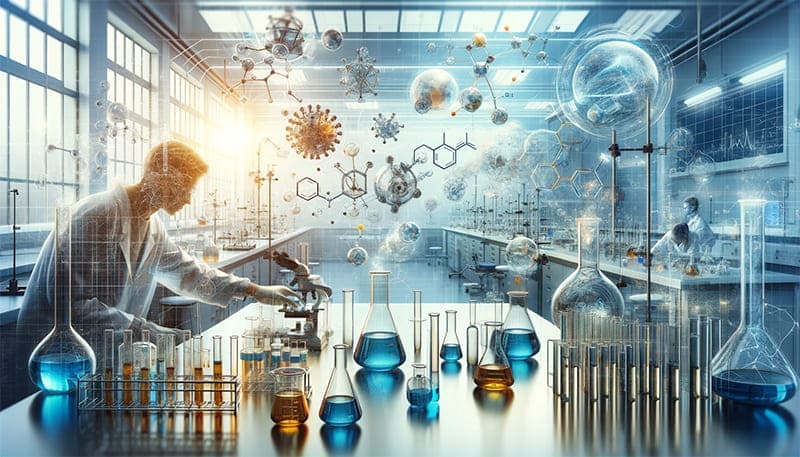
Why is Glassware Essential in Modern Chemistry Labs?
Accuracy, purity, and safety are the cornerstones of chemical research, and glassware plays a pivotal role in ensuring all three. Beakers and flasks, for instance, are designed to provide accurate measurements, essential for replicating results. Borosilicate glass, used in most lab glassware, resists thermal shock and chemical corrosion, ensuring the purity of substances. Safety is paramount in labs, and glassware helps by containing potentially dangerous reactions.
But why glass? The answer lies in its non-reactive nature. Glass does not interact with most chemicals, making it an ideal material for experiments.
How Has Glassware Evolved to Meet Modern Research Needs?
Gone are the days of rudimentary glass tubes and simple containers. Today’s lab glassware is a product of sophisticated engineering and design. For instance, Erlenmeyer flasks have a conical shape and narrow neck, which makes them ideal for mixing chemicals without spillage. Volumetric flasks, with their long neck and flat bottom, are designed for precise volume measurements.
With advancements in material science, researchers now have access to glassware that can withstand extreme temperatures and corrosive substances, expanding the horizons of chemical experimentation.
What Impact Does Advanced Glassware Have on Research Outcomes?
The impact of high-quality glassware on research outcomes cannot be overstated. Accurate measurements lead to replicable results, which is the backbone of credible scientific research. The durability and versatility of modern glassware also mean that researchers can undertake more complex and hazardous experiments, pushing the boundaries of what’s possible in chemical research.
Moreover, the ease of cleaning and sterilizing glassware ensures that experiments are not contaminated, which is crucial for achieving accurate results.
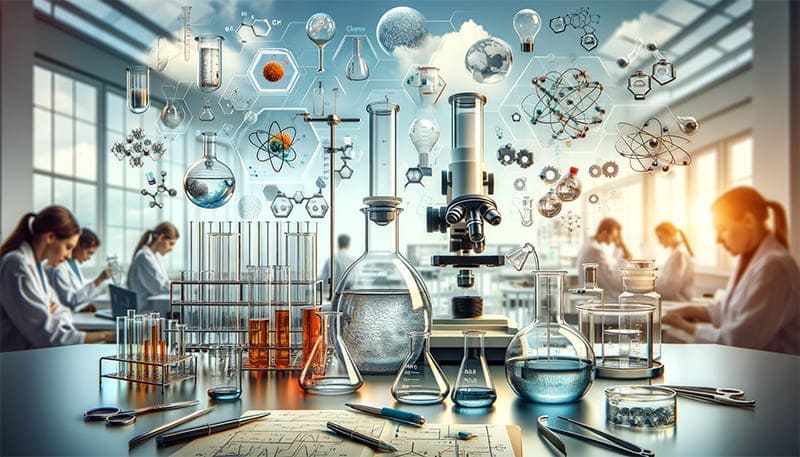
Exploring the Key Roles of Glassware in Chemistry Labs
Glassware in chemistry labs serves multiple critical functions. It’s like the Swiss Army knife of the lab, adaptable and essential for various tasks. Here are some of the main applications of glassware in chemistry labs:
- Chemical Reaction Vessels: Glassware is one of the most common types of containers for chemical reactions. Different types of glassware allow lab personnel to conveniently carry out various chemical reactions, such as solution preparation, reaction vessels, distillation, extraction, etc.
- Sample Processing and Storage: Glassware is often used for sample processing and storage. For example, test tubes, beakers, and volumetric flasks can be used for sample dilution, mixing, precipitation, etc. Glassware is also used to store samples for subsequent analysis and processing.
- Optical Instruments: Some special glassware, known for its high transparency and heat resistance, can be used to make optical instruments like cuvettes and spectrophotometer cells. These instruments are used in studying the absorption spectrum of substances, chromatographic separation, etc.
- Measuring Instruments: Glassware like burettes, volumetric flasks, and pipettes are common measuring instruments in chemistry labs. They offer high precision and stability for measuring and titrating the content of substances in liquids.
- Condensation and Reflux Devices: Glassware is used to make condensation and reflux devices, such as condensers and reflux tubes. These devices are commonly used in distillation and reflux operations in chemical experiments to facilitate the separation and purification of substances.
- Gas Generators and Purifiers: Glassware can be used to create gas generators and purifiers. For example, using separation funnels and flasks made of glass can facilitate the preparation and purification of gases.
- Laboratory Equipment Accessories: Glassware can also serve as accessories for laboratory equipment, like glass joints and tubes in laboratory vacuum systems. These accessories ensure the sealing and stability of experimental equipment.
The application range of glassware in chemistry laboratories is extensive. Different types of glassware are suited to different experimental needs, and lab personnel must choose the appropriate glassware to ensure the accuracy and safety of experiments.
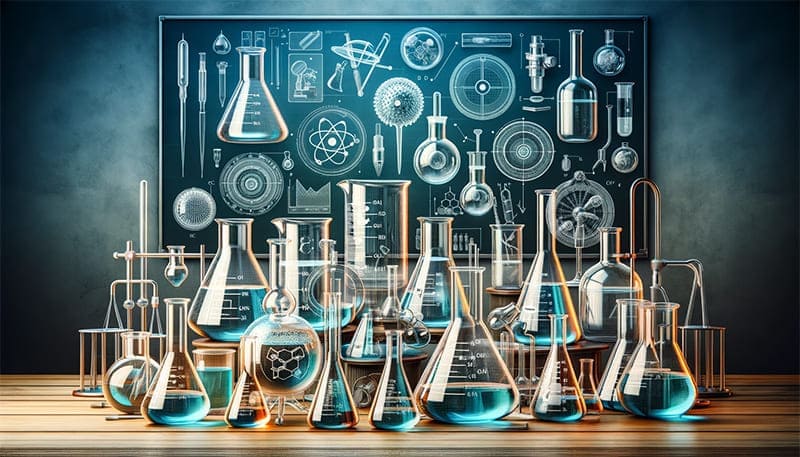
Comprehensive Guide to Laboratory Glassware Name
In the realm of scientific research, understanding the various types of laboratory glassware is crucial for conducting precise and safe experiments. Each piece of glassware has its unique purpose and characteristics, making it indispensable for specific tasks within the lab. This guide aims to provide a detailed overview of the most commonly used laboratory glassware, their materials, uses, features, handling techniques, and safety precautions.
Detailed Overview of Laboratory Glassware
Here’s a comprehensive table that categorizes key types of laboratory glassware, outlining their names, materials, uses, characteristics, handling methods, and safety tips:
| Glassware Type | Material | Uses | Characteristics | Handling Methods | Safety Precautions |
|---|---|---|---|---|---|
| Beaker | Borosilicate glass | Holding liquids, mixing, heating | Graduated, wide mouth, pour spout | Use with beaker tongs for heating | Avoid sudden temperature changes |
| Test Tube | Borosilicate glass | Holding, mixing, or heating small amounts | Cylindrical, open top, rounded bottom | Use test tube holder/clamp | Handle gently to prevent breakage |
| Erlenmeyer Flask | Borosilicate glass | Titration, mixing, heating | Triangular body, narrow neck | Support with clamp/stand | Do not apply direct flame |
| Volumetric Flask | Borosilicate glass | Precise dilutions, standard solutions | Flat bottom, long neck, precise calibration | Fill to marked line only | Handle gently, avoid scratches |
| Burette | Borosilicate glass | Titration, accurate liquid dispensing | Graduated tube with a stopcock | Use with a burette stand | Ensure stopcock is functioning |
| Pipette | Borosilicate glass | Transferring precise liquid volumes | Long, thin tube, various types for different volumes | Use pipette filler/aid | Avoid mouth pipetting |
| Condenser | Borosilicate glass | Distillation, refluxing | Coiled or straight tube, water jacket | Secure with clamps | Check for leaks in cooling water |
| Petri Dish | Borosilicate glass | Culturing microorganisms | Flat dish with a lid | Sterilize before use | Avoid direct flame |
| Funnel | Borosilicate glass | Transferring liquids, filtration | Conical shape, may include filter | Use with filter paper | Align carefully with receiving vessel |
| Graduated Cylinder | Borosilicate glass | Measuring liquid volumes | Tall, cylindrical, marked with graduations | Read at eye level | Place on a flat surface |
| Watch Glass | Borosilicate glass | Holding small samples, covering beakers | Concave, round glass | Handle gently, use as a lid | Avoid using as a dish for strong reactions |
| Dropping Bottle | Borosilicate glass | Dispensing small amounts of liquids | Small bottle with a dropper | Use the dropper for controlled dispensing | Store upright to prevent spills |
| Retort | Borosilicate glass | Distillation | Flask with a long, downward facing neck | Secure properly, handle with care | Use with a flame diffuser for even heating |
| Separatory Funnel | Borosilicate glass | Liquid-liquid extractions, phase separations | Conical shape with a stopcock at the bottom | Support with ring stand and clamp | Open stopcock slowly to control flow |
| Gas Washing Bottle | Borosilicate glass | Purifying gases | Bottle with inlets/outlets for gas flow | Connect securely to gas source | Check for proper gas flow direction |
| Drying Tube | Borosilicate glass | Drying gases | Tube filled with drying agents | Attach securely to apparatus | Handle with care to prevent breakage |
| Desiccator | Borosilicate glass | Storing moisture-sensitive substances | Airtight container with a desiccant | Open and close gently | Monitor desiccant for saturation |
| Mortar and Pestle | Porcelain or glass | Grinding or mixing solids | Bowl (mortar) and heavy club (pestle) | Grind with gentle, circular motions | Clean thoroughly after each use |
| Schlenk Flask | Borosilicate glass | Reactions under inert atmosphere | Flask with sidearm and stopcock for gas flow | Use with inert gas supply | Handle with care under vacuum or pressure |
| Soxhlet Extractor | Borosilicate glass | Continuous extraction of compounds from solids | Setup with siphoning system for solvent recycling | Assemble correctly with condenser | Monitor temperature and solvent level |
This extended list of laboratory glassware provides a more comprehensive view of the tools essential for various chemical experiments and processes. Each type of glassware, made primarily from durable borosilicate glass, has specific features and uses that cater to the diverse needs of a chemistry laboratory. Understanding these details, along with proper handling techniques and safety precautions, is vital for any researcher or student working in the lab. This guide serves as a foundational resource, ensuring informed, safe, and effective use of laboratory glassware.
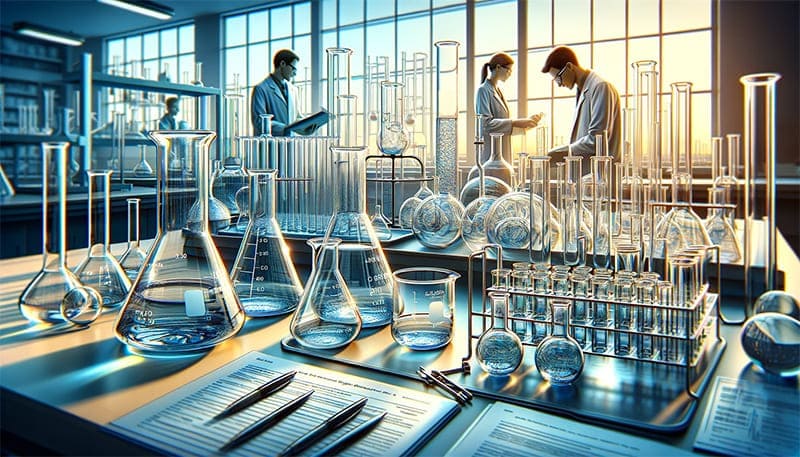
Choosing the Right Glassware: A Critical Decision
Choosing the right glassware for a chemistry laboratory is crucial for the accuracy of experiments and the safety of the personnel involved. Here are several aspects to consider when selecting glassware:
- Material: The glassware should be made of high-quality glass that is heat-resistant, corrosion-resistant, strong, and highly transparent. Common materials include borosilicate glass, quartz glass, and high silica glass. Choosing the appropriate material based on the specific experimental requirements and the chemicals used ensures the reliability and safety of the equipment.
- Specifications: The size and capacity of glassware, such as beakers, flasks, and test tubes, should be selected based on the requirements of the experiment and the scale of the laboratory. The right specifications meet experimental needs while ensuring the longevity and ease of use of the equipment.
- Structure: Glassware should have a simple design that is easy to clean and maintain. Complex designs can make cleaning difficult and may lead to residue build-up. Prioritize glassware that is simple in structure and easy to operate.
- Sealability: For experiments involving corrosive or toxic substances, the sealability of glassware is very important. Choosing equipment with good sealing properties can prevent the leakage and spread of harmful substances, ensuring the safety of laboratory personnel.
- Pressure Resistance: Some chemical experiments may require the use of high-pressure reactors or high-temperature vessels. In such cases, selecting glassware with good pressure resistance is vital. Glassware that lacks pressure resistance can break or explode, posing risks to people and the environment.
- Transparency: High transparency is important for experiments where observing the process or results of chemical reactions is necessary. Glassware with high transparency allows clear observation of experimental progress and reaction conditions, which is beneficial for accuracy.
- Acid and Alkali Resistance: Depending on the nature of the chemicals used in the experiment, choose glassware with appropriate acid and alkali resistance. Some acidic or alkaline substances can corrode glassware, so selecting more resistant equipment ensures accuracy and safety.
- Brand and Quality: Choosing glassware from reputable brands and ensuring quality can guarantee performance and lifespan. Reliable brands usually offer better after-sales service and technical support, which is beneficial for long-term use and management in the laboratory.
- Personal Preference and Experience: Personal preferences and past experiences of the laboratory personnel can also influence the choice of glassware. Some may prefer certain brands or types of equipment based on previous experiences. However, these preferences should align with scientific principles and laboratory needs to ensure accuracy and safety.
When selecting glassware for a chemistry laboratory, it’s important to consider material, specifications, structure, sealability, pressure resistance, transparency, acid and alkali resistance, brand and quality, as well as personal preferences and experience. By considering these factors comprehensively, you can choose high-quality glassware that meets the needs and standards of the laboratory, ensuring accuracy and safety in experiments.
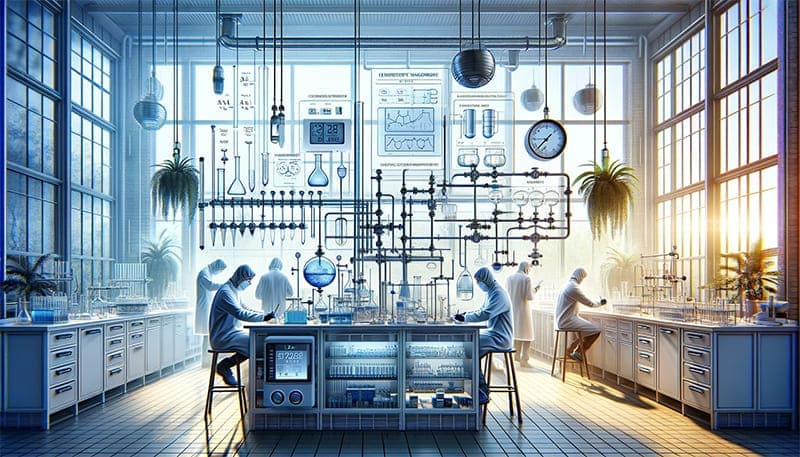
The Environment Around Glassware in Labs
The environment in which glassware is used in a chemistry laboratory has specific requirements to ensure the accuracy and reliability of experimental results, as well as the safety of laboratory personnel. Here are some key aspects:
- Laboratory Temperature and Humidity: The temperature and humidity of the laboratory should be effectively controlled. Typically, the temperature should be maintained between 20-25°C, and the humidity should be between 40%-60%. Both high and low temperatures and humidity levels can adversely affect experimental results.
- Laboratory Cleanliness: Laboratories should be kept clean and dry to prevent dust and contaminants. Laboratory personnel must follow hygiene regulations, maintain personal cleanliness, such as washing hands frequently, wearing gloves, etc. Additionally, laboratory equipment should be regularly cleaned and maintained.
- Laboratory Ventilation: A well-ventilated laboratory is essential to ensure air circulation. Harmful gases or fumes may be generated during experiments, and poor ventilation can be hazardous to laboratory personnel. Therefore, appropriate ventilation equipment, such as fume hoods and exhaust fans, should be installed.
- Laboratory Lighting: Adequate lighting facilities are necessary to ensure that laboratory personnel can operate in good light conditions. Lighting fixtures should also meet safety standards, such as using explosion-proof lights.
- Laboratory Fire Safety: Effective fire-fighting facilities, like fire extinguishers and fire hydrants, should be available in the laboratory. Flammable and explosive chemicals may be used in experiments, making the provision of fire safety equipment essential.
- Water and Electricity Safety in the Laboratory: The use of resources such as water, electricity, and gas in the laboratory should meet safety standards. For example, taps should be intact and leak-free; electrical outlets should meet safety standards and wires should not be damaged; gas cylinders should be safe and reliable, and gas valves should not leak.
- Laboratory Waste Disposal: Waste generated in the laboratory should be properly managed. For instance, waste liquids should be collected separately and sent to designated waste liquid treatment stations; solid waste should be collected and sent to designated waste disposal sites; waste gases should be vented outdoors through ventilation systems.
The environment for the use of glassware in a chemistry laboratory should be effectively controlled and managed to ensure the accuracy and reliability of experimental results and the safety of laboratory personnel. Additionally, laboratory personnel must strictly adhere to laboratory regulations and operating procedures to ensure the safety and smooth progress of experiments.
Safety and Maintenance: A Critical Aspect
The handling, maintenance, and safety protocols associated with each type of glassware are as important as their functional roles. Breakages, chemical incompatibilities, and incorrect usage can lead to compromised results or even hazardous situations. Thus, training and adherence to safety guidelines are non-negotiable aspects of working with glassware in modern labs.
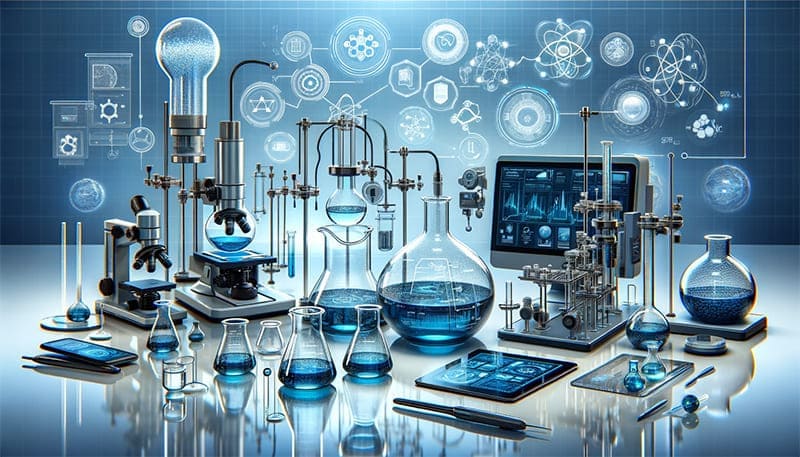
Integrating Technology with Traditional Glassware
In an era where technology infiltrates every aspect of scientific research, glassware has not remained untouched. The integration of traditional glassware with digital measuring devices, automated systems, and advanced material coatings is elevating the capabilities of these essential lab tools.
Digital Measuring Devices: Precision and Ease
The introduction of digital measuring devices in glassware, such as digital burettes and pipettes, has revolutionized precision in liquid handling. These devices offer enhanced accuracy, reducing the margin of error significantly compared to traditional methods. Additionally, digital readouts simplify the measurement process, making it more efficient and user-friendly. This advancement is particularly vital in experiments requiring high precision, such as pharmaceutical research and biochemistry.
Automated Systems: Consistency and Reproducibility
Automation in glassware technology, such as automated titration systems and robotic handling of glassware, brings consistency and reproducibility to experiments. These systems minimize human error and variability, ensuring that experiments can be replicated with the same conditions and outcomes. In areas like materials science and environmental testing, where consistency is key, automated glassware systems are invaluable.
Advanced Material Coatings: Enhancing Durability and Safety
The application of advanced coatings to glassware has significantly improved its durability and safety. Coatings such as polymer-based films can prevent glass from shattering, reducing the risk of injury and contamination. This advancement is particularly crucial in high-impact environments, like industrial laboratories, where the safety and longevity of glassware are paramount.
Smart Glassware: Connectivity and Real-Time Analysis
The concept of smart glassware, embedded with sensors and connected to data analysis software, is paving the way for real-time monitoring of experiments. These smart devices can track parameters like temperature, pH, and pressure, transmitting data directly to researchers’ computers or mobile devices. This real-time analysis capability allows for immediate adjustments and more dynamic experimental processes, critical in fast-paced research fields such as synthetic chemistry and nanotechnology.
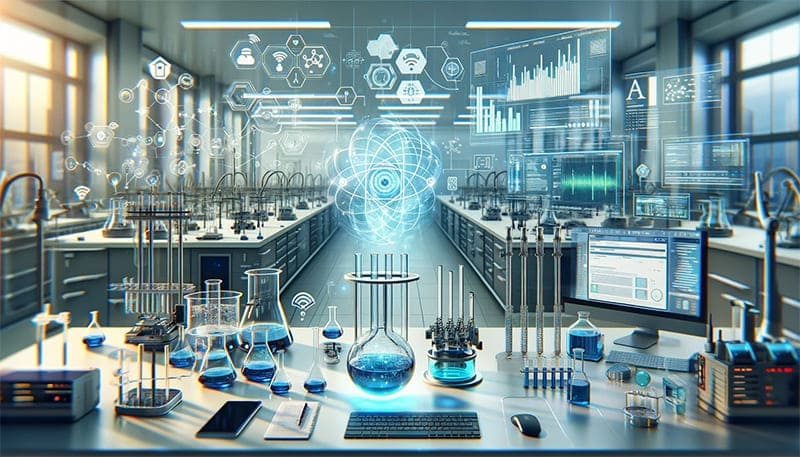
Smart Lab Glassware: Envisioning the Future of Laboratory Experiments
As we look toward the future, the integration of smart technology with traditional glassware in laboratories presents a realm of exciting possibilities. This fusion is expected to transform how experiments are conducted, monitored, and analyzed, making the laboratory environment more efficient, precise, and interconnected. Here’s a projection of the potential advancements and applications of smart glassware in future laboratories, considering current technological trends.
Advanced Sensors and Real-Time Analytics
Future smart glassware will likely incorporate advanced sensors capable of measuring a wide array of chemical and physical properties. These could include sensors for pH, temperature, pressure, concentration of specific ions or molecules, and even radioactivity. The data collected by these sensors would be transmitted in real-time to laboratory information management systems (LIMS), allowing for immediate analysis and decision-making. This could significantly speed up experimental processes and improve the accuracy of results.
AI-Driven Predictive Analysis
Integrating artificial intelligence (AI) with smart glassware can revolutionize experimental protocols. AI algorithms could analyze data from ongoing experiments and predict outcomes, enabling preemptive adjustments to the experimental conditions. This predictive analysis could minimize errors and optimize results, particularly in complex reactions or when working with novel compounds.
Seamless Integration with Automated Laboratory Systems
Smart glassware could be designed to seamlessly integrate with automated laboratory systems, such as robotic arms and automated storage and retrieval systems. This integration would enable the automated setup of experiments, adjustments based on real-time data, and even automatic cleaning and sterilization of glassware. Such a system would enhance efficiency and reduce the need for manual intervention.
Enhanced Safety with Alert Systems
Future smart glassware could incorporate safety features like automatic alert systems for hazardous conditions. If a reaction becomes too volatile or a harmful substance is detected, the glassware could send alerts to laboratory personnel or even initiate emergency protocols, such as shutting down reactions or activating ventilation systems.
Wireless Connectivity and Cloud Data Management
Wireless connectivity will be a key feature, allowing smart glassware to communicate with other lab equipment and cloud-based data management systems. Researchers could monitor experiments remotely through mobile devices or computers, accessing data stored in the cloud. This connectivity could also facilitate collaboration between researchers in different locations, sharing data and findings in real-time.
Customizable and Adaptive Glassware
With advancements in manufacturing technologies like 3D printing, future smart glassware could be highly customizable. Researchers could design glassware with specific shapes, volumes, and integrated sensor arrays tailored to particular experiments. Moreover, glassware could adaptively change its properties, like surface coating or porosity, in response to the chemical environment.
Sustainable and Eco-Friendly Innovations
Sustainability will also be a crucial aspect of future smart glassware. Innovations might include self-cleaning surfaces to reduce water and chemical usage or materials that change color to indicate contamination, reducing the need for excessive testing.
Conclusion: A Transformative Horizon
The future of smart glassware in laboratories is not just about incremental improvements but a transformative shift in how scientific research is conducted. These advancements promise a more connected, efficient, and intelligent laboratory environment, where experiments are safer, faster, and more reliable. As technology continues to evolve, the potential of smart glassware seems limited only by the imagination, opening new horizons for scientific exploration and discovery.

Sustainable Practices in Glassware Usage
In line with global sustainability efforts, the use of glassware in chemistry labs also reflects an environmental consciousness. The durability and reusability of glassware reduce waste compared to disposable alternatives, aligning lab practices with eco-friendly initiatives.
Conclusion: Glassware – An Enduring Ally in Scientific Exploration
The extensive variety of glassware in modern chemistry labs underscores its indispensability in research and experimentation. Each piece, from beakers to condensers, plays a unique role in facilitating scientific discoveries. As we embrace technological advancements, the evolution of glassware continues, ensuring that it remains an integral and versatile tool in the ever-changing landscape of scientific research. Through its diverse applications, glassware not only supports but also drives innovation, making it a true ally in the world of modern scientific exploration.










